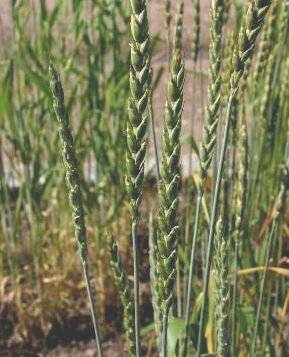
Triticum spelta Assembly and Gene Annotation
About Triticum spelta
Triticum spelta (Spelt) was an important staple food in parts of Europe from the Bronze Age to medieval times. Now it survives as a relict crop in Central Europe and northern Spain, and has also found a new market as a health food. Spelt is sometimes considered a subspecies of the closely related species common wheat (Triticum aestivum).
Assembly
The genome assembly was constructed using the DeNovoMAGIC3.0 assembly pipeline, previously used for the wild emmer wheat [2], durum wheat [3] and Chinese Spring RefSeqv1.0 assemblies [1]. Briefly, high-molecular-weight DNA was extracted from wheat seedlings. Illumina 450-bp paired-end (PE), 800-bp PE and mate-pair (MP) libraries of three different sizes (3 kb, 6 kb and 9 kb) were generated. Sequencing was performed at the University of Illinois Roy J. Carver Biotechnology Center. 10X Genomics Chromium genome libraries were prepared and sequenced at the Genome Canada Genome Innovation Centre using the manufacturers’ recommendations to achieve a minimum of 30 coverage. Hi-C libraries were prepared. Using the Illumina PE, MP, 10X Genomics Chromium, and Hi-C, chromosome scale assemblies were prepared.
Annotation
116,868 genes were lifted over from the IWGSC RefSeq v1.1 annotation [1]. De novo gene annotation is currently being worked on and will be added at a later stage.
References
- Shifting the limits in wheat research and breeding using a fully
annotated reference
genome.
Rudi Appels, Kellye Eversole, Catherine Feuillet, Jan Rogers, Ian Small, Manuel Spannagl, David Swarbreck, Cristobal Uauy et al. 2018. Science. 361 - Wild emmer genome architecture and diversity elucidate wheat
evolution and
domestication.
Raz Avni, Moran Nave, Omer Barad, Kobi Baruch, Sven O. Twardziok, Heidrun Gundlach, Iago Hale, Martin Mascher, Manuel Spannagl, Krystalee Wiebe et al. 2017. Science. 357:93-97. - Durum wheat genome highlights past domestication signatures and
future improvement
targets.
Marco Maccaferri, Neil S. Harris, Sven O. Twardziok, Raj K. Pasam, Heidrun Gundlach, Manuel Spannagl, Danara Ormanbekova, Thomas Lux, Verena M. Prade, Sara G. Milner et al. 2019. Nature Genetics. 51:885895.
More information
General information about this species can be found in Wikipedia.
Statistics
Summary
| Assembly | PGSBv2.0_Spelta, INSDC Assembly GCA_903994165.1, 2019 |
| Database version | 111.1 |
| Golden Path Length | 14,453,523,434 |
| Genebuild by | 10+ consortium |
| Genebuild method | External annotation import |
| Data source | 10+ consortium |
Gene counts
| Coding genes | 116,395 |
| Pseudogenes | 3,709 |
| Gene transcripts | 120,104 |



![Follow us on Twitter! [twitter logo]](/i/twitter.png)
